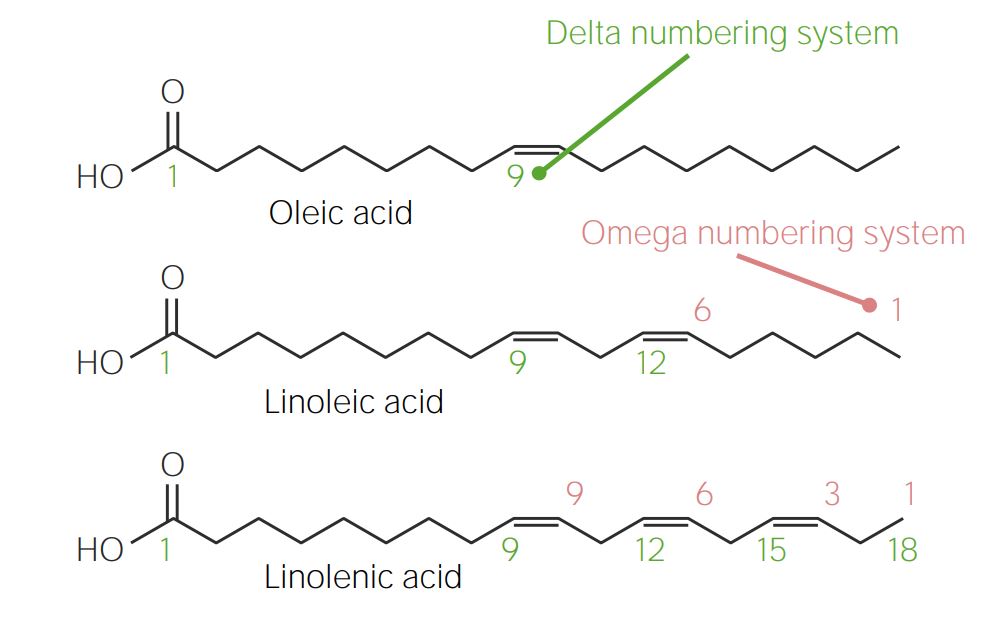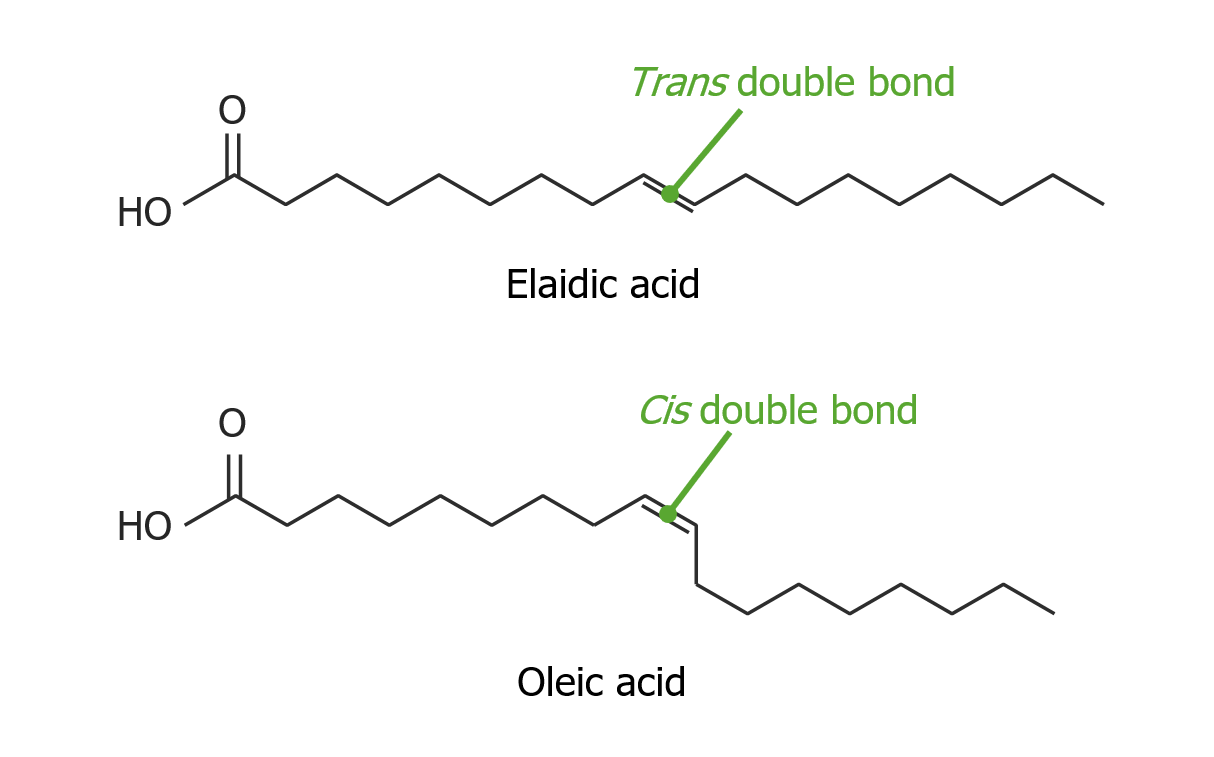Playlist
Show Playlist
Hide Playlist
Beta Oxidation of Fatty Acids
-
07 Advanced LipidMetabolism-Fat&FattyAcids.pdf
-
Reference List Biochemistry.pdf
-
Download Lecture Overview
00:00 Now to breakdown fatty acids, we go through a process called beta oxidation, so I wanna steps us through that. 00:09 The enzymes forbid oxidation are found in mitochondria and little organelles called peroxisomes. 00:17 This process of breaking down fat generates more ATP per carbon than sugars do. 00:23 Now sugar metabolism is very important and sugar metabolism is occurring more readily than fatty acid metabolism is, partly; because, sugar can travel in the blood stream more easily than fat and fatty acids can. 00:36 Fatty acid metabolism works in a breakdown process that proceeds by a chopping off of two carbons at a time from a fatty acid. 00:44 And you can see that happening in this process here. 00:48 On the top I have a schematic representation of a fatty acid and I have marked the two carbon pieces that get chopped off. 00:55 We see first of all, the release of the fatty acid and the fatty acid is broken between what are called the α-carbon, as you can see here, and the β-carbon here. 01:05 So in the numbering scheme that's here, that's between carbons numbers 2 and 3. 01:10 So either term is commonly used. 01:13 That breakdown process, as I said, releases a single acetyl-CoA that's a two carbon piece. 01:19 And then continues along at two carbons at a time until the entire fatty acid has been broken down. 01:25 Now fatty acid oxidation is a multi-step process like most metabolic pathways. 01:32 But there has to be some processing of the fatty acids to get them ready for the oxidation. 01:37 Fatty acids that start in the cytoplasm have to first be activated and then moved into the mitochondrion but, as we will see that process is a little odd. 01:46 The activation of a fatty acid begins in the cytoplasm. 01:51 And this involves the attachment to the fatty acid of a molecule called coenzyme A or as people more commonly say CoA. 01:59 This is an energy requiring step and as you can see that ATP energy is needed to do this and the product of this is not ADP, as we have seen many times before, but actually AMP and that's reflection of the fact this is a pretty high energy bond that's being created. 02:15 The result of this action is a molecule called fatty acyl-CoA. 02:20 Now fatty acyl-CoA needs to get into the mitochondrion where the oxidation occurs. But there is a little complication with that. 02:28 The acyl-CoA won't directly go into the mitochondrion so the cell has wasted some energy, in some thought, by putting this CoA onto the acyl-CoA and then we see it gets taken off. 02:41 So the next step of the process starting in the cytoplasm on the left we see that the acyl-CoA is combined with a molecule called carnitine to make an acyl-carnitine. 02:51 Now this step is essential for the movement of the acyl-group into the mitochondrion. 02:58 And the reason is, is that CoA just can't make that move across the lipid bilayer. 03:04 I should also mention that we are looking at the mitochondrion here. 03:07 So on the right side, where it says the MATRIX, we are talking about the inside of the mitochondrion, and of course, on the left side where it says CYTOSOL we are talking about the cytoplasm of the cell. 03:17 In between the two you see the yellow and blue lines that are drawn there and those relate to two layers of membrane covering the mitochondrion. 03:25 The yellow one being what's called the outer layer and blue one what's the inner layer. 03:31 The blue one is very impermeable to a lot of substances whereas the yellow one is fairly permeable. 03:35 So you see the acyl-carnitine moving into what's called the intermembrane space, the space between the yellow and blue lines, and then when it gets there it encounters the yellow protein there that is a transfer protein that physically moves the acyl-carnitine into the mitochondrion matrix, as you see. 03:54 Now once it gets to the mitochondrion then the reverse of all of this process actually happens. 03:58 The CoA that was floating around the mitochondrion is now attached to the acyl group and the carnitine is released. 04:06 The carnitine ultimately makes it back out into the cytoplasm and the process continues. 04:10 So what we done here is that we described here as a shuttle. The shuttle has carried acyl group from the cytoplasm into the mitochondrion. 04:19 We have an acyl-CoA in there and the acyl-CoA is the target for the oxidation. 04:24 Beta oxidation proceeds now starting with that acyl-CoA. 04:28 So we see now the step by step process where by a fatty acid is oxidized. 04:34 The oxidation in this process is shown in the first step below. 04:38 We see an enzyme called acyl-CoA-dehydrogenase and it does the very first reaction on that fatty acid. 04:45 You can see that all the action in fatty acid oxidation occurs between carbons 2 and 3 or the α and β depending upon how you call it. 04:56 The first oxidation is removal of electrons and protons and those are donated to FAD to make FADH2. 05:05 The result of that oxidation creates a trans bonded fatty acid called trans delta 2 Enoyl-CoA. That name isn't very commonly used by the way. 05:15 But the important thing is the trans fatty acid and I note that it's really relate to trans fat. Trans fat happens or is made for other reasons. This is a normal intermediate in fatty acid degradation. 05:27 Trans fat is typically made by chemical treatment of food. 05:31 Now there are three forms of this enzyme. There is a form that works on long fatty acids, typically longer than about 20 or so. A form that works on medium size fatty acids between about 18 and 10 carbons. 05:45 And then there is a form that works on short fatty acids typically less than 10 carbons. 05:50 Now of note the acyl-CoA-dehydrogenase that works on the medium form of the acid is a form that is absent in infants who have died from sudden infant death syndrome. 06:01 Now it's not a cause-effect but there appears to be a relationship between the absence of this enzyme and SIDS. 06:07 Now the FADH2 that was generated in this process can be taken into oxidative phosphorylation and used to make ATP. 06:16 So we are seeing at these oxidative processes are used to generate energy that a cell can use for other purposes. 06:23 Now in the second reaction of fatty acid oxidation we see that this trans intermediate gets a water added across it. 06:31 This is a very common reaction in organic chemistry, and it's catalyzed by the enzyme Enoyl-CoA-Hydratase. 06:38 This Enoyl-CoA-Hydratase creates a molecule that has a hydroxyl group on the beta, carbon or carbon number 3, and that hydroxyl group is in the L configuration, as you can see here. 06:50 Now this reaction is similar to a reaction that occurs in the citric acid cycle. In fact this reaction and the next two reactions are very similar to citric acid cycle reactions. 07:02 And this allows for a oxidation that will occur in the next step. 07:08 So the second oxidation of fatty acyl-CoAs occurs by the process that you can see here. 07:15 On the bottom you see that we have the hydroxyl fatty acid that we created on the last step and on this step we see that the hydroxyl group is converted into a ketone. 07:25 That oxidation is catalyzed by the enzyme that you see on the screen and causes production of NADH plus H+. 07:34 That is the transfer of electrons and protons, as we have seen before. 07:38 Now this reaction is similar to the malate dehydrogenase reaction of the citric acid cycle. This reaction is preparing us for the final step in which we will actually cleave the fatty acid into two pieces. 07:53 The NADH, of course, like the FADH2, can be used to generate ATP and oxidative phosphorylation. 08:01 Now on the last step of the process we see the keto of acyl-CoA that was created in the last step of the process being broken into two pieces. 08:12 So the bond between carbons 2 and 3 or the α and β, as you can see here, is broken and the product of that is an acyl-CoA that is being shorten by two carbons and an acetyl-CoA. 08:23 Now the acetyl-CoA itself can be targeted for additional oxidation in the citric acid cycle. 08:31 If we look at the oxidation, for example, of the fatty acid palmitate which has 16 carbons, the complete oxidation of that fatty acid can generate close to a 140 ATPs. 08:42 So fatty acids have a lot of energy stored with inside of them. 08:45 Now the thiolase enzyme that catalyzes this reaction is interesting; because, obviously it is catalyzing this breakdown. But also the reverse reaction of this creates an important intermediate if the acyl-CoA only has 2 carbons. 09:01 So if we have an acyl-CoA that only has two carbons, on the right side, then we can combine that with the acetyl-CoA Well an acyl-CoA that contains 2 carbon is also acetyl-CoA. So what thiolase does is it can take two acetyl-CoAs and make a four carbon intermediate. 09:21 Now as we will see later that's an important consideration for making lipids called ketone bodies.
About the Lecture
The lecture Beta Oxidation of Fatty Acids by Kevin Ahern, PhD is from the course Lipid Metabolism.
Included Quiz Questions
Which of the following statements about fatty acid oxidation is NOT true?
- It breaks off three-carbon pieces and converts them to acetyl-CoA molecules.
- It occurs in mitochondria and peroxisomes.
- It generates more ATP per carbon than sugars.
- It is chemically similar to the reverse of fatty acid synthesis.
In the transport of fatty acids into the mitochondrion, which of the following occurs?
- Carnitine is on the fatty acid as it crosses the mitochondrial membrane.
- They are first attached to ACP.
- They are first removed from carnitine.
- Co-A is removed from the fatty acid and replaced with carnitine in the mitochondrion.
Which of the below enzymes catalyzes the conversion of two acetyl CoA units into acetoacetyl CoA?
- Thiolase
- Acyl-CoA dehydrogenase
- Acetyl-Co-A dehydrogenase
- Delta-2-enoyl-CoA acetyltransferase
- Enoyl-CoA-hydratase
Which of the following enzymes catalyzes the formation of a trans-bonded fatty acid?
- Acyl-CoA dehydrogenase
- Acetyl-coenzyme A acetyltransferases (ACAT)
- Thiolase
- Delta-2-enoyl-CoA acetyltransferase
- Enoyl-CoA-hydratase
Which of the following enzyme is usually linked with sudden infant death syndrome (SIDS)?
- Acyl-CoA dehydrogenase
- Acetyl-coenzyme A acetyltransferases (ACAT)
- Thiolase
- Delta-2-enoyl-CoA acetyltransferase
- Hydroxyacyl-CoA-dehydrogenase
Customer reviews
5,0 of 5 stars
| 5 Stars |
|
1 |
| 4 Stars |
|
0 |
| 3 Stars |
|
0 |
| 2 Stars |
|
0 |
| 1 Star |
|
0 |
I finally understood why keto diet is so effective :) Thank you Dr. Kevin!





